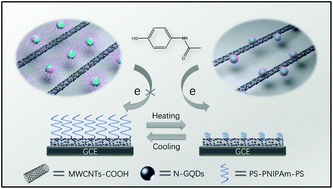Stimuli-enabled switch-like paracetamol electrochemical sensor based on thermosensitive polymer and MWCNTs-GQDs composite nanomaterial†
Abstract
A temperature-controlled switchable electrochemical sensor was constructed based on a composite film consisting of thermosensitive block polymer poly(styrene-b-(N-isopropylacrylamide)-b-styrene) (PS-PNIPAm-PS), carboxylated multi-walled carbon nanotubes (MWCNTs-COOH) and amino-functionalized graphene quantum dots (N-GQDs). The prepared sensor showed good temperature sensitivity and reversibility in sensing paracetamol. In the low temperature environment, the polymer stretched to bury the electroactive sites of the carbon nanocomposite, and the paracetamol could not pass through the polymer to achieve electronic exchange, representing the “closed” state. Conversely, in the high temperature environment, the polymer shrank to expose the electroactive sites and enlarge background currents, the paracetamol was able to undergo the redox reaction normally and generate the response current, representing the “on” state. In addition, the sensor had a wide detection range (0.1 to 7.0 μM and 7.0 to 103.0 μM) and a low LOD of 66 nM for paracetamol. This switch-like sensor provided a novel idea for the application of thermosensitive polymers.

- This article is part of the themed collection: Nanocarbons


 Please wait while we load your content...
Please wait while we load your content...